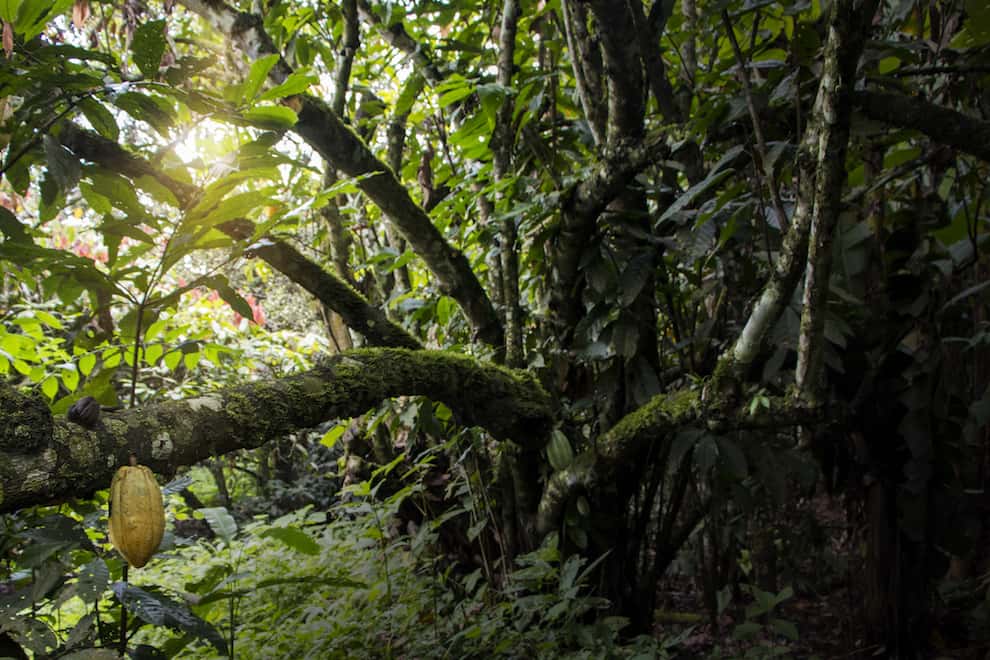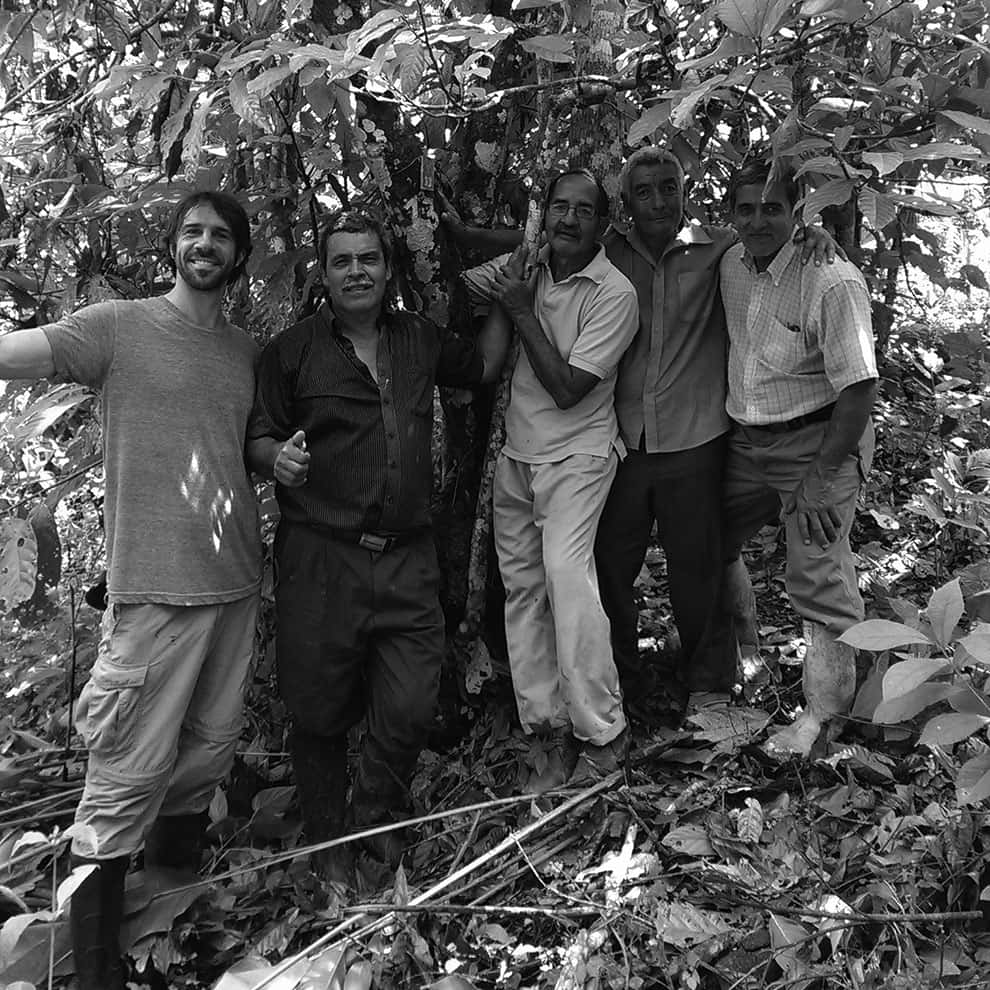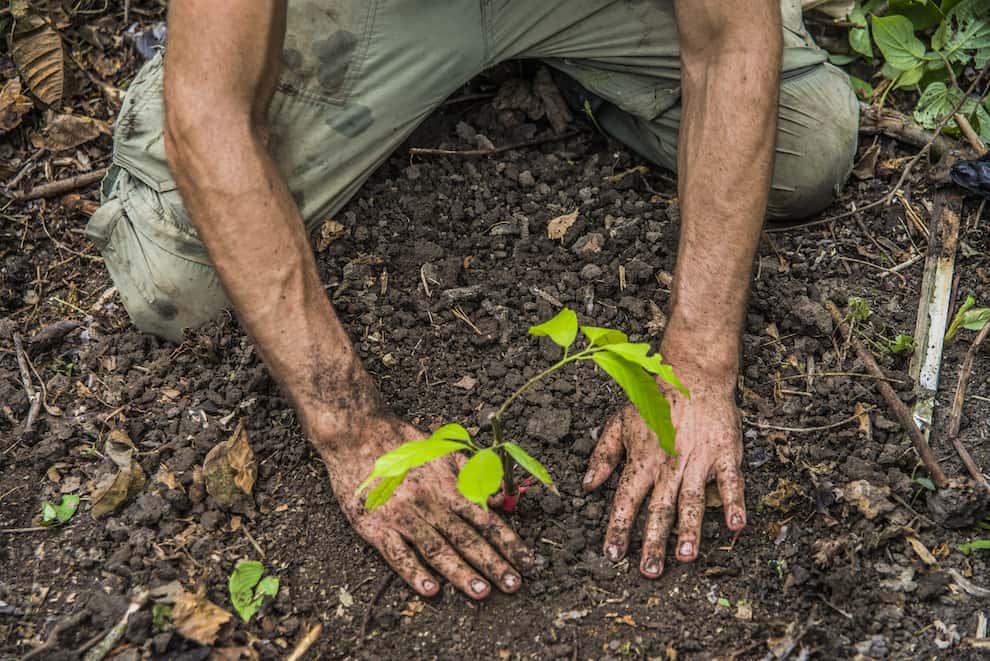
The Noah's Ark of Ancient Nacional Cacao
, by Jerry Toth , 13 min reading time

, by Jerry Toth , 13 min reading time
Imagine that all of the pinot noir vines in the world were lost to disease and hybridization, except in one or two forgotten valleys in Burgundy. That’s basically the situation that Nacional cacao is in today. This is the story about what we're doing to keep the world's most historic cacao variety alive, starting with a single hillside in Ecuador.
Imagine that all of the pinot noir vines in the world were lost to disease and hybridization, except in one or two forgotten valleys in Burgundy. That’s basically the situation that Nacional cacao finds itself in today. "Ancient Nacional" cacao—as in, 100% pure Nacional—was believed to be extinct as recently as 2009. In 2013, we found a valley where some of the last survivors still grow, which was verified by DNA-testing thanks to the Heirloom Cacao Preservation Fund.
Prior to the planting that is discussed in this article, there were only 15 DNA-verified Ancient Nacional trees in all of Ecuador, and each of these trees was already at the end of its expected lifespan. Fearing the end of a 5,300-year-old genetic lineage, we took cuttings from nine of these trees and grafted them onto 189 seedlings, which are now safely planted in a micro-parcel (our "genetic bank") within a protected forest preserve. As of 2021, these young trees will be capable of producing enough cuttings to reproduce over five thousand 100% pure Nacional cacao trees each year.
This is the story about what we're doing to keep the world's most historic cacao variety alive, starting with a single hillside in Ecuador. We call it the Noah's Ark of Ancient Nacional cacao.
Update: You can see the complete timeline of this project, updated in 2021, in the article "Heirloom Cacao Conservation Timeline."
Nacional is the oldest cacao variety in the world, and for centuries it was prized by chocolatiers for its fragrant aroma and signature flavor profile. The illustrious history of Nacional begins 5,300 years ago and was presumably over by 2009, at which point it was believed to be extinct.
The key date in that account, for the purposes of Nacional’s genetic history, is 1917. That was the year that Frosty Pod disease first began to infect cacao trees in Ecuador, which was then immediately followed by Witches’ Broom disease in 1921. Prior to the arrival of these two fungal diseases, effectively all cacao trees in coastal Ecuador were pure Nacional. Many trees died and cacao yields rapidly declined in the 1920s, whereupon foreign cacao varieties were introduced and a century of hybridization began.
For a deep-dive into the history and genetics of Nacional cacao, check out The Near-Extinction of Ancient Nacional Cacao.

Servio Pachard inspecting pure Nacional seedlings destined for the Genetic Bank.
In 2013, Carl and I got in touch with Servio Pachard, who had been a friend and mentor to me since the founding of the Jama-Coaque Ecological Reserve in 2007. Servio is a fourth-generation cacao grower and something of a legendary character in the organic agroforestry scene in Ecuador. Carl and I explained to Servio that we wanted to find the oldest cacao trees in the entire country. Servio’s very first response to this question was Piedra de Plata.
Piedra de Plata is a valley about two hours upstream from Servio's own farm. He remembers going there with his father once as a little boy, back when there were no roads into Piedra de Plata—the only way to get there was via horse or canoe. Back then it was a lawless place, because there was no easy way for the law (or anyone else) to get there. People routinely carried revolvers in their belts as recently as the 1990s. That was one thing he remembered. The other thing he remembered was how old the cacao trees were, and this was over thirty years ago.
"Carl and I explained to Servio that we wanted to find the oldest cacao trees in the entire country. Servio’s very first response to this question was Piedra de Plata."
Piedra de Plata was finally connected by road to the rest of the country in the mid 1990s. In later years, Servio also made a few trips to Piedra de Plata as an agricultural specialist hired by the provincial government of Manabí, and again he saw those groves of old-growth cacao trees. So when Carl and I asked him about old-growth cacao, Piedra de Plata was Servio’s answer.
The three of us made the trek there together the very next day. We met with some of the growers and they showed us their cacao trees, many of which were planted by the grandfathers and even great-grandfathers of men who are currently grandfathers themselves. Doing the math, we calculated that some of these trees were planted during the first two decades of the twentieth century. This meant that some of them pre-dated the arrival of Frosty Pod and Witches’ Broom disease in 1917-1921. It also meant that these same trees somehow survived the epidemic and have therefore proven resistant to these diseases.

Pure Nacional cacao tree in Piedra de Plata, verified by DNA analysis. Most likely planted shortly after the turn of the last century.
We hypothesized that some of these old-growth cacao trees in Piedra de Plata must be 100% pure Nacional. In addition to their old age, many of these same trees also exhibited the primary indicators of pure Nacional—namely, yellow fruit pods (as opposed to red or reddish); elliptical in shape (as opposed to oblong or orbicular); attenuate apex (as opposed to acute or obtuse); moderate basal constriction (as opposed to no constriction or pronounced constriction); and reddish stamen pedicels of the flowers (as opposed to unpigmented pedicels).[1]
In 2015, we put this hypothesis to the test. In partnership with the Heirloom Cacao Preservation Fund, we analyzed the DNA of 47 trees in Piedra de Plata. We collected the leaf samples under the direction of Freddy Amores, the director of cacao research at Ecuador’s leading agricultural institute (INIAP). The genetic analysis was performed by Dr. Lyndel Meinhardt and Dr. Dapeng Zhang at the USDA-ARS genetic lab in Maryland.
"Before the results were compiled, we were politely warned by numerous people within the industry that we would probably not find any pure Nacional cacao trees in Piedra de Plata or anywhere else."
Before the results were compiled, we were politely warned by numerous people within the industry that we would probably not find any pure Nacional cacao trees in Piedra de Plata or anywhere else. To put the rarity of pure Nacional into context, INIAP collected DNA samples from 11,000 cacao trees throughout Ecuador in 2009, and only six of these trees (out of 11,000 samples!) were 100% pure Nacional. That’s a mere 0.05% of the cacao trees that were surveyed.[2]
In addition to these six trees in Ecuador (located in two farms, La Gloria and Las Brisas), a third site with pure Nacional was discovered in the Marañon valley in northern Peru, close to the Ecuadorian border. Aside from these three sites, it was commonly believed that pure Nacional no longer existed.
Out of a broad sampling of 47 cacao trees in Piedra de Plata, in which trees of all ages and characteristics were analyzed, we identified sixteen trees that we believed could be pure Nacional. Among these sixteen trees, nine of them proved to be 100% pure Nacional.
The first thing we did was mark each of the nine trees with a placard, hung by a durable steel chain, and marked with colored flagging tape. We also held a meeting with the cacao growers in Piedra de Plata to announce the findings, and everyone was in agreement that these trees must be conserved at all costs. Each of these trees has since lived the life of a minor celebrity, posing for photos and even doing a bit of acting for a video crew from National Geographic.

Standing in front of a DNA-verified pure Nacional tree in Piedra de Plata, Ecuador – Jerry Toth, Divino Loor, Fernando Cantos, Arnoldo Ganchozo, and Rámon Loor (left to right).
Our main concern, however, was how old they were. At 100-120 years of age, each of these trees is already at the end of its expected lifespan, and theoretically could die any year now. From what we’ve been told, the pure Nacional trees in La Gloria and Las Brisas have already been lost, meaning that these nine trees in Piedra de Plata represent the last-known pure Nacional trees in all of Ecuador.
Therefore the next and most important step was to reproduce these trees before they die. I immediately collected seeds from these trees and germinated them in our tree nursery in the nearby Jama-Coaque Ecological Reserve. Once they reached a suitable height, I planted 150 seedlings in a protected plot of land. But there’s a catch here. Although these seeds were obtained from 100% pure Nacional trees, there is no guarantee that the seedlings themselves are pure Nacional, because they were open-pollinated. The only guarantee is that the mother tree is pure Nacional; we don’t know who the father trees were. There is a decent chance that some of the father trees were also pure Nacional, and we are awaiting a round of genetic testing on these seedlings with the help of Texas State University.
"The more certain method was to take cuttings from the pure Nacional trees and graft them onto the seedlings. This is the only way to ensure that the seedlings are genetically identical to the mother tree."
The more certain method was to take cuttings from the pure Nacional trees and graft them onto the seedlings. This is the only way to ensure that the seedlings are genetically identical to the mother tree. For this step, we called upon the technical assistance of Paul Cedeño, an agricultural specialist from the provincial university, Escuela Superior Politécnica de Manabí (ESPAM). With the help of Paul and his team, we took cuttings from each of the nine trees and grafted them onto seedlings. Specifically, we produced 21 clones of each of the pure Nacional trees, producing a total of 189 pure Nacional seedlings.
The other partner we called upon in this project is Third Millennium Alliance (TMA), the nonprofit rainforest conservation I co-founded in 2007, which manages the Jama-Coaque Ecological Reserve. In addition to the plot of land where I planted the 150 open-pollinated seedlings, we established a second experimental plot to receive the 189 grafted seedlings, to serve as a Genetic Bank. We call it the “Noah’s Ark” of Ancient Nacional cacao. Within three years, these young trees will provide enough cuttings to reproduce up to 5,000 pure Nacional seedlings each year, which will then be distributed to any local cacao grower who wants to help save this historic variety from extinction.

The Jama-Coaque Reserve at dusk. Incidentally, this photograph was actually taken the same day we transplanted most of the seedlings into the Genetic Bank.
It bears mentioning that our goal is not to replace all the cacao in Ecuador with 100% pure Nacional cacao. In a biological sense, the intermingling of the genetic pool is a good thing; it promotes adaptation to evolving ecological pressures, such as disease and climate change. After all, genetic diversity is the mark of evolution, without which none of this would exist.
Even if it was possible to go back to a situation in which all cacao in Ecuador was 100% Nacional, it would not be preferable to do so. This is what left Ecuadorian cacao especially vulnerable to disease in the 1920s. It would also provoke a cacao shortage in Ecuador, because pure Nacional yields 4x less cacao than the pervasive cultivar known as CCN-51, which is basically the opposite of pure Nacional. CCN-51 produces very high yields but is known for extremely poor flavor characteristics. Whereas pure Nacional is on the brink of extinction, CCN-51 is the source of much of the bulk chocolate that is consumed in the world today.
"First and foremost, our goal is to keep this ancient variety alive."
First and foremost, our goal is to keep this ancient variety alive. The Genetic Bank is a place where pure Nacional is now protected and where new seedlings can be reproduced, which we will then distribute to a network of cacao growers across the country. We envision a future in which there are enough growers of pure Nacional cacao to ensure the long-term survival of the variety, but we never expect pure Nacional to ever rise above a small minority of heirloom growers.
In terms of the viability of this next generation of pure Nacional cacao, it should be noted that the pure Nacional trees from Piedra de Plata (which provided the cuttings for the Genetic Bank) are all trees that survived the outbreak of disease in the early 1900s, and have lived their entire lives in proof of their resistance to those diseases. In theory, this new generation will be similarly resistant.
"We would like to at least reduce the gap in productivity between pure Nacional and CCN-51, which would provide heirloom cacao growers in Ecuador with more of an incentive to include pure Nacional trees in their repertoire."
Then comes the issue of productivity. Once these young seedlings begin to bear fruit, we will breed the highest-yielding individuals with each other, in pursuit of a relatively higher-yielding pure Nacional cultivar. Not with the intention of out-competing CCN-51 purely in terms of productivity. We would like to at least reduce the gap in productivity between pure Nacional and CCN-51, which would provide heirloom cacao growers in Ecuador with more of an incentive to include pure Nacional trees in their repertoire—preferably alongside Nacional hybrids, rather than CCN-51.
Last but not least, our secondary goal, once these young trees begin to produce fruit, is to make chocolate with it. We want to share this ancient ride of flavors with generations to come. This is our dream, and the Genetic Bank is the first of many steps towards making it a reality.

References
[1] Soria JV and Enriquez GA. (1988). International Cacao Cultivar Catalogue. Technical Bulletin #6. Centro Agronómico Tropical de Investigación y Enseñanza (CATIE): Costa Rica, 14.
[2] Christian, M. (2012, December). The Mother ‘F’ Tree. C-Spot.